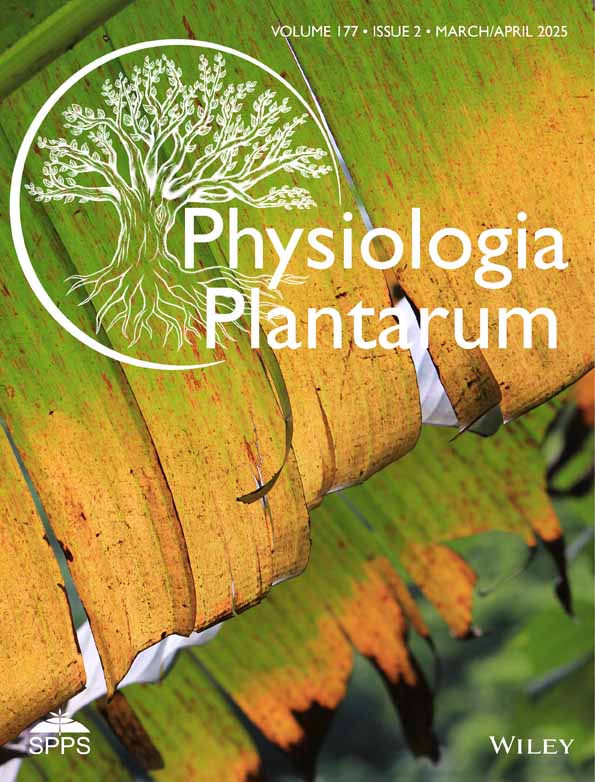High hydraulic safety, water use efficiency and a conservative resource-use strategy in woody species of high-altitude environments: A global study
Abstract
Understanding the impact of altitude on leaf hydraulic, gas exchange, and economic traits is crucial for comprehending vegetation properties and ecosystem functioning. This knowledge also helps to elucidate species' functional strategies regarding their vulnerability or resilience to global change effects in alpine environments. Here, we conducted a global study of dataset encompassing leaf hydraulic, gas exchange, and economic traits for 3391 woody species. The results showed that high-altitude species possessed greater hydraulic safety (Kleaf P50), higher water use efficiency (WUEi) and conservative resource use strategy such as higher leaf mass per area, longer leaf lifespan, lower area-based leaf nitrogen and phosphorus contents, and lower rates of photosynthesis and dark respiration. Conversely, species at lower altitudes exhibited lower hydraulic safety (Kleaf P50), lower water use efficiency (WUEi) and an acquisitive resource use strategy. These global patterns of leaf traits in relation to altitude reveal the strategies that alpine plants employ for hydraulic safety, water use efficiency, and resource, which have important implications for predicting forest productivity and acclimation to rapid climate change.
1 INTRODUCTION
Recent studies in trait-based vegetation ecology, particularly concerning leaf hydraulic, gas exchange and the economics spectrum (Asner et al., 2016; Carlson et al., 2016; Pan et al., 2020) have shown that the inter-specific and intra-specific plasticity of these traits is linked to environmental gradients, which may help predict their forthcoming evolutionary adaptations to climate change (Guo et al., 2017; He et al., 2023; Tian et al., 2016; Wang et al., 2015). Among these gradients, altitude plays a crucial role in shaping the geographical ranges of species because it greatly affects plant performance, growth, and survival due to lower temperatures, precipitation and atmospheric pressure (Arce et al., 2021; Jump et al., 2009; Li & Bao, 2014). Therefore, understanding these traits along altitude gradients can clarify plant physiological and structural adaptations to varying environmental factors, such as temperature, air pressure, humidity, and light intensity.
Leaf hydraulic traits, which are primarily characterized by hydraulic efficiency (i.e. maximum leaf hydraulic conductance; Kleaf-max) and safety (i.e. leaf water potential at 50% loss of Kleaf-max; Kleaf P50), are key physiological parameters that can predict how climate variability will affect species productivity and mortality (Blackman et al., 2009, 2014; Scoffoni et al., 2012). The lower temperature and reduced atmospheric pressure of high-altitude environments are accompanied by increases in water viscosity and faster diffusion rate, respectively (Arce et al., 2021), which subsequently lower the Kleaf-max and impose water stress. Therefore, species at high-altitude environments are likely to develop a safer water transport system to maintain regular physiological processes. The lower Kleaf-max is attributed to changes in leaf venation architecture, especially vein density (Buckley et al., 2017; Scoffoni et al., 2011), that greatly influence xylem and outside-xylem properties (Cochard et al., 2004; McKown et al., 2010; Scoffoni et al., 2017). The link between Kleaf P50 and water availability has been investigated at local and global scales, and previous studies have reported more negative Kleaf P50 (indicating higher hydraulic safety) in habitats with lower precipitation (Blackman et al., 2012, 2014; Nardini et al., 2012; Nardini & Luglio, 2014; Scoffoni & Sack 2017). Studies have also shown lower Kleaf-max and more negative Kleaf P50 with increasing altitude at the local or community scale (Petit et al., 2011; Yao et al., 2024). However, how leaf hydraulic traits vary with altitude remains understudied over broad geographical areas, but this knowledge would improve our understanding of the influence of altitude on plant distribution and ecosystem functioning.
Furthermore, the reduced partial pressure of atmospheric gases at high altitudes reduces the availability of CO2 for photosynthesis. Therefore, plants exhibit phenotypic plasticity by increasing their stomatal density and narrowing their stomatal apertures, so as to respond to this decreased pressure (Kammer et al. 2015) that will ensure an optimal supply of CO2 for photosynthesis (Xu et al., 2016) and restrict water loss to counteract increased transpiration rate (Buckley, 2005), respectively. Therefore, species in high-altitude environments are likely to enhance their intrinsic water use efficiency (WUEi) due to a smaller decline in A relative to gs. Some studies done on a local scale have shown the positive contribution of altitude in increasing WUEi in shrubs (Yao et al., 2024) or trees (Wang & Feng, 2012), which would provide a competitive advantage for the plants in this challenging environment that is characterized by low temperatures and a short growing season.
Another group of traits, which is characterized as the leaf economics spectrum (LES), encompasses the photosynthetic efficiency (Amax), dark respiration rate (Rd-max), foliar nutrient contents (N, P), leaf mass per area (LMA) and leaf longevity (LL), which fundamentally affects vegetation properties and ecosystem functioning (Osnas et al., 2013; Reich et al., 1997; Reich, 2014; Wright et al., 2004). Generally, species with an acquisitive resource-use strategy can maximize their photosynthetic performance through greater area-based leaf nitrogen (N) and phosphorus (P) contents, which is typical of high-fertility ecosystems at low altitudes. This strategy also involves lower investment in leaf construction (low LMA), which results in shorter leaf lifespans (LL) (Finegan et al., 2015; Santiago & Wright, 2007). On the contrary, species with a conservative resource-use strategy can minimize photosynthetic performance due to low leaf N and P contents, and this is typical of low-fertility ecosystems such as those at high altitudes. These species also invest more in leaf construction (high LMA), which results in longer leaf lifespans (LL) (Poorter et al., 2009; Reich, 2014). Studies about LES have focused on a variety of ecosystems at a global scale, including forests, grasslands (Dray et al., 2014; Onoda et al., 2017) and wetlands (Pan et al., 2020). However, research examining the LES across an altitudinal gradient remains limited.
Studying the changing patterns of leaf hydraulic, gas exchange and economic traits with altitude is crucial for comprehending the hydraulic and water-use strategies as well as the functioning of high-altitude species from a resource utilization perspective. Here, to understand plant adaptations to high-altitude environments, we compiled a comprehensive global database from published sources relating to leaf hydraulic, gas exchange, and economic traits of 3391 woody species from 1211 genera and 234 families distributed along an altitudinal gradient. We hypothesized that global species that dominate at high altitudes would display more negative Kleaf P50 (high hydraulic safety), higher WUEi and tend toward a conservative resource-use strategy to maximize their survival in this challenging environment.
2 MATERIAL AND METHODS
2.1 Leaf trait data
We collected data on leaf hydraulic efficiency (Kleaf-max) and safety (KleafP50), stomatal conductance (gs), and photosynthetic rate (A) from 232 relevant publications (Supplementary material; Table S1), only considering woody plants confined to their natural habitat. We excluded laboratory incubation studies and manipulative experiments conducted under any specific treatment. Graphical data was digitized using Origin Pro 8 SR0 (Origin Lab Corporation). We calculated the ratio of hydraulic supply to demand (Kleaf/gs) and intrinsic water use efficiency (WUEi) using the ratio of Kleaf-max/gs-max and Amax/gs-max, respectively. We also compiled values of dark respiration rate (Rd-max – μmol m−2 s−1), leaf area-based nitrogen (Narea – g m−2) and phosphorus (Parea – g m−2) content, leaf mass per unit area (LMA – g m−2), and leaf longevity (LL – months) from the TRY global plant trait database (https://www.try-db.org/TryWeb/Home.php) (Kattge et al., 2011). We used all replicate values to account for variability and increase the robustness of our statistical analysis. Our dataset included 7949 observations of 9 variables related to leaf hydraulic (Kleaf-max, Kleaf P50) gas exchange (Amax, gs-max), and economic traits (Amax, Rd-max, LMA, LL, Narea, Parea), collected across 3391 species.
2.2 Climatic variables
We obtained the geographical coordinates (i.e. latitude & longitude) for each species' native habitat from the Global Biodiversity Information Facility (GBIF; https://www.gbif.org). Given the abundance of coordinates for each species, we based the species' current native habitat on the occurrence from the most recent year. When multiple records were found in the most recent year, we included all the corresponding coordinates. Using these coordinates, we extracted values for altitude, mean annual precipitation (MAP) and mean annual temperature (MAT) from raster maps downloaded from the WorldClim historical climate database (http://www.worldclim.org) (Fick & Hijmans, 2017) with the help of Arc Map (v.10.8) software. Additionally, we downloaded 30 years of monthly precipitation and temperature data (1970–2000) from the WorldClim database. For the months with ≥4°C mean temperature and precipitation ≥2X mean temperature, we then calculated growing season mean climatic variables, such as temperature, precipitation, and growing season length (Lasky et al., 2012). Annual heat moisture index (HMI) was calculated as (MAT +10) / (MAP/1000) (Roach et al., 2021). We acquired atmospheric pressure data since 1979 from the Multi-Source Weather (MSWX) product, a comprehensive meteorological dataset that has been corrected for biases. This dataset provides global coverage and has a spatial resolution of 0.1° (Beck et al., 2022). The partial pressures of O2 and CO2 were calculated by multiplying the fraction of the gas by total atmospheric pressure (Hlastala 2006). Using ArcMap (v.10.8) software, we generated a world map to represent the geographical distribution of species along the altitude gradient (Figure 1).
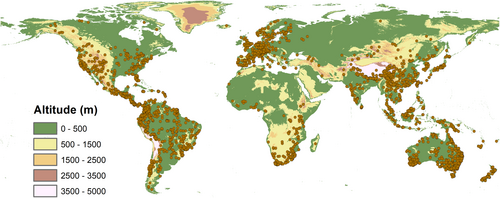
2.3 Phylogenetic tree
We constructed a phylogenetic tree of 3,391 woody plant species using the phylo.maker function in the V. PhyloMaker package in R (R Core Team, 2022) (Figure S1). Blomberg's K statistic was used to quantify the extent to which related species resemble one another in terms of leaf hydraulic, gas exchange and economic traits.
2.4 Data analysis
A simple linear regression analysis was used to assess both the relationships between environmental variables and altitude and trait–trait relationships. We performed a linear mixed-effects model using the R package “lme4” to evaluate the relationships between leaf hydraulic, gas exchange and economic traits and altitude in each site (i.e. latitude and longitude), with species used as random effects and altitude as a fixed effect. We conducted Spearman's correlation analysis to evaluate the trait-climate associations, and results were visualized using a heatmap. Bivariate relationships of leaf traits with climate were evaluated by performing standardized major axis (SMA) regression analysis in the R package “smatr”. We estimated Blomberg's K to evaluate the phylogenetic signals of leaf traits among woody species using the R package “phytools”. All statistical analysis was completed in R 3.1.0 (https://www.r-project.org/).
3 RESULTS
3.1 Changes in climatic variables along an altitudinal gradient
Mean annual precipitation (MAP), growing season precipitation (Pgs) and the annual heat moisture index (HMI) showed statistically significant negative correlations with altitude (Figure 2; R2 = 0.01–0.08, p < 0.001). In addition, mean annual temperature (MAT) and growing season temperature (Tgs) decreased linearly with altitude (Figure 2; R2 = 0.33–0.34, p < 0.001) and explained about 34% of variation by altitude. Among all climatic variables used in our analysis, altitude displayed a negative correlation (Figure 2; R2 = 0.90–0.91, p < 0.001) and explained the greatest proportion of variance (about 90%) in atmospheric pressure (AP), partial pressure of O2 (PPO2) and partial pressure of CO2 (PPCO2). We also observed a substantial explanatory power of altitude on growing season length (GSL), with GSL decreasing as altitude increased (Figure 3; R2 = 0.34, p < 0.001).
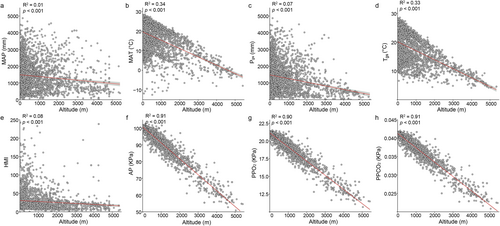
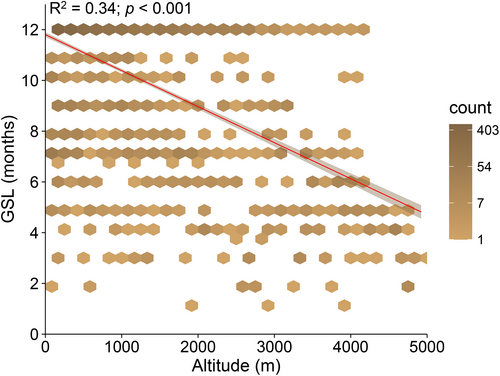
3.2 Changing patterns of leaf hydraulic, gas exchange and economic traits with increasing altitude
To examine global patterns of leaf hydraulic traits in relation to altitude, we performed analysis using a linear mixed-effects model, with sites and species as random effects, and showed that leaf hydraulic efficiency (Kleaf-max), ranging between 0.98 to 100 mmol m−2 s−1 MPa−1, declined linearly with increasing altitude (Figure 4a; R2 = 0.12, p = 0.01). Similarly, we observed a negative correlation between leaf water potential at 50% loss of Kleaf (Kleaf P50) and altitude, with values ranging from −0.09 to −8.35 (Figure 4b; R2 = 0.10, p < 0.001). Thus, species adapted to higher altitudes tended to exhibit lower Kleaf-max and more negative Kleaf P50 compared to species native to lower altitudes, demonstrating a hydraulic efficiency-safety trade-off relationship (Figure 4d; R2 = 0.23, p < 0.001). Furthermore, linear mixed-effects models of stomatal conductance (gs-max) with altitude showed decreasing trends (Figure 4c; p < 0.001) in which fixed effects alone explained a modest portion of variation (marginal R2 = 0.06), whereas both random and fixed effects explained most of the variation (conditional R2 = 0.94).
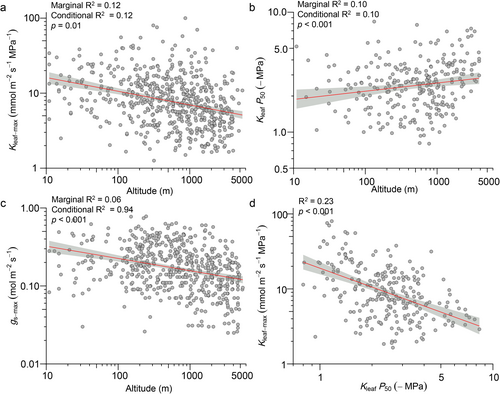
At high altitudes, the significant decrease in Kleaf-max values also led to a lower Kleaf/gs ratio (Figure 5a; R2 = 0.14–0.15, p < 0.001). In contrast, water use efficiency (WUEi) displayed a positive correlation with increasing altitude (Figure 5b; marginal R2 = 0.28, conditional R2 = 0.96, p < 0.001), and species at high altitudes had mean values of 98.79 for WUEi, compared to the 57.86 of species at lower altitudes. We also observed upregulation of WUEi in species with a shorter growing season (Figure S2 R2 = 0.05, p < 0.001). Both photosynthesis (Amax) and dark respiration (Rd) rates declined with increasing altitude and, together, random and fixed effects explained most of the variation (Figure 6; marginal R2 = 0.03–0.08, conditional R2 = 0.98–0.99, p < 0.001). In addition, with increasing altitude, leaf mass area (LMA) and leaf longevity (LL) increased linearly, and area-based nitrogen (N) and phosphorus (P) content decreased linearly (Figure 7; marginal R2 = 0.01–0.03, conditional R2 = 0.01–0.99, p < 0.001). The lower Amax in high-altitude species was associated with lower N and P contents (Figure S3; R2 = 0.07–0.15, p < 0.001).
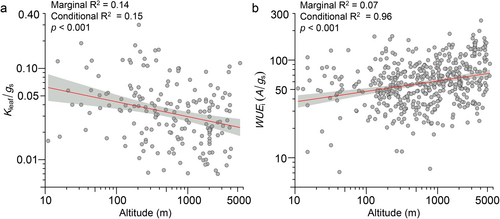
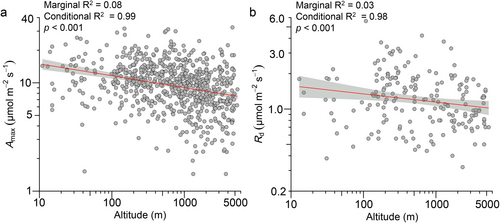
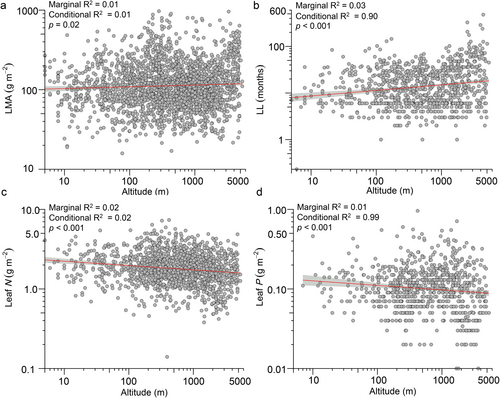
3.3 Relationships between leaf traits and climate variables
Most of the environmental variables had either a positive or a negative influence on leaf hydraulic, gas exchange and economic traits, as shown by the Pearson's correlations displayed in the heatmap (Figure 8). Following standardized major axis (SMA) regression analysis, AP, PPO2 and PPCO2 explained the majority of variation in leaf traits, while other variables, such as MAP, MAT, Pgs, Tgs and HMI, accounted for smaller proportion of variation (Table S2).
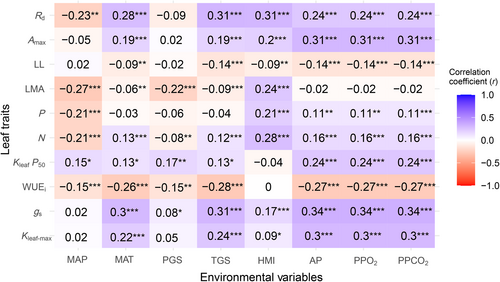
3.4 Phylogenetics
Leaf hydraulic safety (Kleaf P50) displayed a significant phylogenetic signal among woody plant species, as indicated by Blomberg's K > 1, whereas all the other studied leaf traits showed weak phylogenetic control, with Blomberg's K < 1 (Table 1; Figure S1).
| Trait | N | Blomberg's K | p-value |
|---|---|---|---|
| Kleaf-max | 474 | 0.020 | 0.314 |
| gs-max | 507 | 0.011 | 0.842 |
| Kleaf P50 | 212 | 6.57 | 0.001 |
| Kleaf / gs | 155 | 0.043 | 0.363 |
| WUEi | 440 | 0.022 | 0.215 |
| Amax | 669 | 0.010 | 0.464 |
| Rd-max | 181 | 0.066 | 0.098 |
| LMA | 2317 | 0.011 | 0.083 |
| LL | 881 | 0.020 | 0.014 |
| N | 1444 | 0.001 | 0.815 |
| P | 782 | 0.009 | 0.307 |
4 DISCUSSION
High-altitude communities are particularly vulnerable to the impacts of increasing aridity due to shifting climate envelopes. Therefore, studying the spatial variation of leaf traits along altitudinal gradients significantly enhances our understanding of plant functional adaptations fostered by their respective capacities for environmental plasticity. Here, we studied leaf hydraulic, gas exchange and economic traits to assess whether these traits better reflect an adaptation to environmental pressure. We found that high-altitude species possessed greater hydraulic safety (Kleaf P50), higher water use efficiency (WUEi) and conservative resource use strategy, while species at lower altitude exhibited lower hydraulic safety (Kleaf P50), lower water use efficiency (WUEi) and an acquisitive resource use strategy. These divergent strategies enable woody species to adapt to distinct environmental challenges of high-altitude ecosystems.
4.1 Modulation of leaf hydraulic traits by altitude
We compared global patterns of leaf hydraulic efficiency and safety along an altitudinal gradient and found that high-altitude species tend to exhibit lower hydraulic efficiency (Kleaf-max) but their greater hydraulic safety (Kleaf P50) gives them a competitive advantage (Figure 4). Thus, our findings support the hypothesis that species prioritize the construction of safer water transport systems (a more negative Kleaf P50) over hydraulic efficiency to adapt to high-altitude environments (Liu et al., 2019; Tyree & Sperry, 1989). Indeed, it has been shown that freeze–thaw events trigger anatomical changes (i.e. thickening of cell walls and modifications of xylem vessels and vein density) that help plants withstand lower temperatures at higher altitudes by effectively preventing the formation and spread of xylem embolism (Mayr et al., 2003; Petit et al., 2011). These traits enable plants to resist hydraulic impairment by constructing safer water transport systems, maintaining leaf hydraulic function, and consequently, sustaining photosynthetic activity (Mayr et al., 2006; Wang et al., 2018; Waseem et al., 2021, 2024; Scoffoni et al., 2016; Yao et al., 2021a).
Moreover, our study revealed the phylogenetic signal in Kleaf P50 (Table 1), indicating that both evolutionary relationships and environmental pressures are involved in shaping the plasticity of Kleaf P50 among woody species. Pieces of evidence suggest that environmental conditions exert selective pressure while evolutionary history shapes the genetic and structural limits within which these adaptations can occur (Liu et al., 2022; Shahzad et al., 2024; Zhang et al., 2011). Anyway, these patterns indicate that hydraulic safety play a significant role in shaping species distribution along altitude gradients.
Although Kleaf-max increased with altitude among five Rhododendron species (Taneda et al., 2016), our global study of diverse species with greater environmental heterogeneity indicated that Kleaf-max decreased with increasing altitude. The decrease of Kleaf-max with increasing altitude has also been observed in two shrub species (Yao et al., 2024). It has been suggested that higher VLA increases Kleaf-max by shortening the post-venous hydraulic pathway, thereby facilitating more efficient water transportation (Scoffoni et al., 2016), and that altitude-related trends of VLA have shown lower VLA with increasing altitude, tightly related to low Kleaf-max (Yao et al., 2024). Our data show that species growing at higher altitudes tend to have a lower Kleaf/gs ratio than those at lower altitudes (Figure 5a). At lower altitudes, a higher Kleaf/gs ratio would help alleviate the increased evaporative demand caused by high vapour pressure deficit (VPD) (Will et al., 2013). Thus, evaporative cooling helps reduce leaf temperature (Brodribb et al., 2007; Scoffoni et al., 2011, 2016; Yao et al., 2021). In contrast, a higher Kleaf/gs ratio might not be necessary at higher altitudes due to the low VPD in cooler temperatures (Will et al., 2013).
Previous global studies have reported a general hydraulic efficiency-safety trade-off among grasses, shrubs and angiosperm species (Ocheltree et al., 2016; Yan et al., 2020; Yao et al., 2021b). Our findings indicate that species inhabiting high-altitude environments exhibit lower Kleaf-max and more negative Kleaf P50, whereas species in lower altitudes tend to have higher Kleaf-max and less negative Kleaf P50 (Figure 4). This global study strongly supports the hydraulic efficiency-safety trade-off framework along the altitudinal gradient.
4.2 Modulation of gas exchange and leaf economic traits by altitude
The optimization of water use efficiency largely depends on constructing a safe and effective water transport system as well as possessing a coordinated signal pathway to finely adjust stomatal regulation (Brodribb et al., 2017; Yang et al., 2021). Species growing at high altitudes, which experience shorter growing seasons, are characterized by higher water use efficiency compared to those at lower altitudes (Figure 5b, S2). This increased efficiency may be associated with greater sensitivity of stomatal closure to low temperatures and precipitation or to reduced atmospheric pressure or low hydraulic supply in high-altitude environments (Leakey et al., 2019). The increased stomatal sensitivity at high altitudes reduces the rate of evaporation and, in turn, enhances the efficiency of water usage (Picotte et al., 2007; Zou et al., 2010).
Numerous studies have examined the impact of climatic factors, such as precipitation and temperature, on water use efficiency. These studies have shown that species in low precipitation environments increase their water use efficiency (Ponce-Campos et al., 2013; Ogaya and Peñuelas, 2003; Xiao et al., 2013). Similarly, the increased water-use efficiency at high altitudes enables plants to allocate limited water resources more effectively to photosynthetic processes. This adaptation helps mitigate the impact of hydraulic supply limitations and compensates for the short growing season, allowing plants to accumulate more assimilated carbon and enhance their tolerance to extreme alpine environments (Bresson et al., 2009; Ogaya & Peñuelas, 2003). This provides a competitive advantage for plants at high altitudes by maintaining carbon fixation under lower temperatures.
The interrelationship of leaf economic traits has been reported previously both at local and larger scales (Reich et al., 1997, 1999; Wright et al., 2001; Wright & Westoby, 2003; Wright et al., 2004). Here, we have generalized the modulation of these traits by altitude on a global scale. The results showed that species at lower altitude exhibited high foliar N and P content, Amax, Rd-max, coupled with lower LMA and LL. Conversely, species at higher altitude exhibited lower Amax, Rd-max, and foliar N and P contents, but with higher LMA and LL (Figures 6 and 7). From lower to higher altitudes, the observed trait-altitude interactions indicate a continuum of adaptation to temperature, precipitation, and resource constraints along an altitudinal gradient. Thus, species adapted to high altitude environments tend to exhibit a conservative leaf economic trait strategy than those in lower altitude environments at global scale. Species inhabiting high-altitude environments tend to have leaves requiring greater foliar construction costs (high LMA) to cope with stressors such as reduced precipitation, low temperature, strong radiation, and wind (Midolo et al., 2019; Poorter et al., 2009; Zhang et al., 2020).
There are several key aspects in which high LMA can be seen as a strategy of adaptation for high altitude-prone species. Firstly, high LMA with increasing altitude tends to improve the strength or elastic modulus of leaves (Nadal et al., 2023), thus to protect them from damage caused by low temperatures or wind at high altitudes (Lutz, 2010). Secondly, this can be regarded as a strategy to maintain carbohydrate production in stressful environments (Poorter et al., 2009). Finally, structural reinforcement with high LMA protects species from herbivory and other physical hazards (Reich et al., 1997; Wright & Cannon, 2001), and can thereby increase leaf longevity (LL). Furthermore, in our study, the increase in LMA also resulted in a corresponding increase in LL at high altitude environments (Figure 7 a,b), thus suggesting a strong correlation between LMA and LL (Wright et al., 2004, 2005; Zhang et al., 2010), and longer LL can optimize their nitrogen use efficiency by extending N mean residence time, especially where soil decomposition, mineralization, and nutrient absorption rates may be restricted by low temperatures (Escudero et al., 1992; Eckstein et al., 1999; Körner & Paulsen, 2004; Sullivan et al., 2015).
In our global study, species at high-altitude sites displayed lower values of Amax and Rd-max that might be due to the decline in the enzymatic activity of Rubisco caused by colder temperatures and smaller CO2 concentrations in the liquid phase of mesophyll cells (Terashima et al., 1995). Another plausible explanation for this lower gas exchange is the correlation of foliar N and P with Amax and Rd-max. The bulk of nitrogen found in the photosynthetic complex contributes to higher Amax, and to a large extent, phloem loading of photosynthate contributes to the dark respiration rate (Field 1986; Lambers et al., 1998), but species at higher altitudes have lower N. Furthermore, because bioenergetic molecules like ATP and NADPH play a crucial role in photosynthesis and respiration, these metabolic processes (Amax, Rd-max) correlate tightly with phosphorus (Atwell 1999), but species at higher altitudes have lower P. Other factors, such as lower atmospheric pressure and lower partial pressure of O2 and CO2, may also reduce photosynthetic efficiency in high-altitude environments (Friend & Woodward, 1990; Takeishi et al., 2013; Viveros et al., 2024).
Based on the shift of traits, species at lower altitudes exhibited an acquisitive strategy that takes advantage of abundant resources. This is because higher temperatures at lower altitudes stimulate microbial activity and make more resources available for these species to exploit (Raich & Schlesinger, 1992). Conversely, species at higher altitudes exhibited a conservative strategy exists to cope in less fertile ecosystems. Low temperatures at high altitudes hamper soil biological activity, thus further limiting soil decomposition and mineralization and reducing the availability of soil nutrients (N, P) as altitude increases (Sundqvist et al., 2013; Vincent et al., 2014).
5 CONCLUSIONS
Based on a global study of 3391 woody species spanning altitudes up to 5000 meters, we have generalized strategies for leaf hydraulic, gas exchange, and economics traits. The results indicate that, from lower to higher altitudes, species exhibit lower Kleaf-max, more negative Kleaf P50, and higher WUEi. Furthermore, high-altitude species adopt a conservative resource use strategy, while low altitude species tend to exhibit an acquisitive resource use strategy. The combination of high hydraulic safety, increased water use efficiency, and conservative resource use strategy enables woody species to adapt to cold temperatures, short vegetation periods, and less fertile ecosystems at high altitudes (Figure 9).
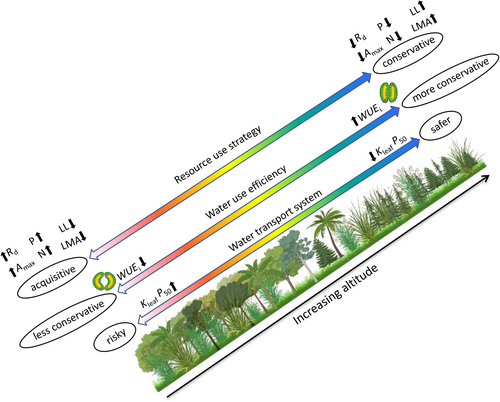
AUTHOR CONTRIBUTIONS
MW and XWF designed this study. MW, MMH, LH, KZ, TSS and GQY contributed to data collection and analysis. MW, YK, MC and XWF contributed to data interpretation, and visualization. FM and JS performed phylogenetic analysis. MW wrote the manuscript with inputs from YK, MC, CS and XWF. XWF supervised the project.
ACKNOWLEDGMENTS
We thank all the researchers whose datasets were open to the public and used in our study.
FUNDING INFORMATION
The research was partially supported by the National Natural Science Foundation of China (Nos 32325036, 32171491), Gansu Science and Technology Major Project (22ZD6FA052, 24RCKB001, 22ZD6NA007, 24ZD13NA016), top leading talents in Gansu Province and the RUDN University Strategic Academic Leadership Program.
Open Research
DATA AVAILABILITY STATEMENT
The full dataset that supports the findings of this study is available from the corresponding author upon reasonable request.



